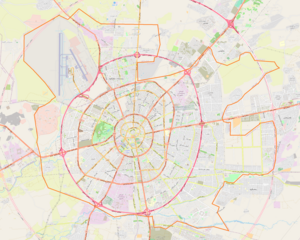Citadel of Arbil
| Erbil citadel | |
|---|---|
| Kurdish: Qelay Hewlêr, Arabic: قلعة أربيل | |
| Erbil, Iraqi Kurdistan, Iraq | |

Aerial view of the Erbil citadel
|
|
| Coordinates | 36°11′28″N 44°00′32″E / 36.191°N 44.009°E |
| Site information | |
| Open to the public |
Yes |
| Condition | Partially ruined |
| Site history | |
| Built | Unknown |
| Battles/wars | Siege by the Mongols (1258) |
| Official name | Erbil Citadel |
| Type | Cultural |
| Criteria | iv |
| Designated | 2014 (38th session) |
| Reference no. | 1437 |
| State Party | Iraq |
| Region | Arab States |
The Erbil Citadel, locally called Qalat (Kurdish: قەڵای ھەولێر Qelay Hewlêr; Arabic: قلعة أربيل) is a tell or occupied mound, and the historical city centre of Erbil in the Kurdistan Region of Iraq. The citadel has been inscribed on the World Heritage List since 21 June 2014.
The earliest evidence for occupation of the citadel mound dates to the 5th millennium BC, and possibly earlier. It appears for the first time in historical sources in the Ebla tablets around 2,300 BC, and gained particular importance during the Neo-Assyrian period. During the Sassanian period and the Abbasid Caliphate, Erbil was an important centre for Christianity. After the Mongols captured the citadel in 1258, the importance of Erbil declined. During the 20th century, the urban structure was significantly modified, as a result of which a number of houses and public buildings were destroyed. In 2007, the High Commission for Erbil Citadel Revitalization (HCECR) was established to oversee the restoration of the citadel. In the same year, all inhabitants, except one family, were evicted from the citadel as part of a large restoration project. Since then, archaeological research and restoration works have been carried out at and around the tell by various international teams and in cooperation with local specialists. The government plans to have 50 families live in the citadel once it is renovated.
The buildings on top of the tell stretch over a roughly oval area of 430 by 340 metres (1,410 ft × 1,120 ft) occupying 102,000 square metres (1,100,000 sq ft). The only religious structure that currently survives is the Mulla Afandi Mosque. The mound rises between 25 and 32 metres (82 and 105 ft) from the surrounding plain. When it was fully occupied, the citadel was divided in three districts or mahallas: from east to west the Serai, the Takya and the Topkhana. The Serai was occupied by notable families; the Takya district was named after the homes of dervishes, which are called takyas; and the Topkhana district housed craftsmen and farmers.
...
Wikipedia

